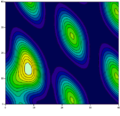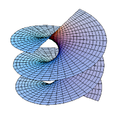- Multivariable calculus
-
Multivariable calculus (also known as multivariate calculus) is the extension of calculus in one variable to calculus in more than one variable: the differentiated and integrated functions involve multiple variables, rather than just one.
Contents
Typical operations
Limits and continuity
A study of limits and continuity in multiple dimensions yields many counter-intuitive results not demonstrated by single-variable functions. There exist, for example, scalar functions of two variables having points in their domain which, when approached along any arbitrary line, give a particular limit, yet give a different limit when approached along a parabola. The function
approaches zero along any line through the origin. However, when the origin is approached along a parabola y = x2, it has a limit of 0.5. Since taking different paths toward the same point yields different values for the limit, the limit does not exist.
Partial differentiation
Main article: Partial derivativeThe partial derivative generalizes the notion of the derivative to higher dimensions. A partial derivative of a multivariable function is a derivative with respect to one variable with all other variables held constant.
Partial derivatives may be combined in interesting ways to create more complicated expressions of the derivative. In vector calculus, the del operator (
 ) is used to define the concepts of gradient, divergence, and curl in terms of partial derivatives. A matrix of partial derivatives, the Jacobian matrix, may be used to represent the derivative of a function between two spaces of arbitrary dimension. The derivative can thus be understood as a linear transformation which varies from point to point in the domain of the function.
) is used to define the concepts of gradient, divergence, and curl in terms of partial derivatives. A matrix of partial derivatives, the Jacobian matrix, may be used to represent the derivative of a function between two spaces of arbitrary dimension. The derivative can thus be understood as a linear transformation which varies from point to point in the domain of the function.Differential equations containing partial derivatives are called partial differential equations or PDEs. These equations are generally more difficult to solve than ordinary differential equations, which contain derivatives with respect to only one variable.
Multiple integration
Main article: Multiple integralThe multiple integral expands the concept of the integral to functions of many variables. Double and triple integrals may be used to calculate areas and volumes of regions in the plane and in space. Fubini's theorem guarantees that a multiple integral may be evaluated as a repeated integral.
The surface integral and the line integral are used to integrate over curved manifolds such as surfaces and curves.
Fundamental theorem of calculus in multiple dimensions
In single-variable calculus, the fundamental theorem of calculus establishes a link between the derivative and the integral. The link between the derivative and the integral in multivariable calculus is embodied by the famous integral theorems of vector calculus:
In a more advanced study of multivariable calculus, it is seen that these four theorems are specific incarnations of a more general theorem, the generalized Stokes' theorem, which applies to the integration of differential forms over manifolds.
Applications and uses
Techniques of multivariable calculus are used to study many objects of interest in the physical world. In particular,
Domain/Range Applicable techniques Curves 

Lengths of curves, line integrals, and curvature. Surfaces 
Areas of surfaces, surface integrals, flux through surfaces, and curvature. Scalar fields 

Maxima and minima, Lagrange multipliers, directional derivatives. Vector fields 

Any of the operations of vector calculus including gradient, divergence, and curl. Multivariable calculus can be applied to analyze deterministic systems that have multiple degrees of freedom. Functions with independent variables corresponding to each of the degrees of freedom are often used to model these systems, and multivariable calculus provides tools for characterizing the system dynamics.
Multivariable calculus is used in many fields of natural and social science and engineering to model and study high-dimensional systems that exhibit deterministic behavior. Non-deterministic, or stochastic systems can be studied using a different kind of mathematics, such as stochastic calculus.
See also
External links
- MIT video lectures on Multivariable Calculus, Fall 2007
- UC Berkeley Video Course - Multivariable Calculus (poor audio quality)
- Multivariable Calculus: A free online textbook by George Cain and James Herod
- Multivariable Calculus Online: A free online textbook by Jeff Knisley
- Multivariable Calculus – A Very Quick Review, Prof Blair Perot, University of Massachusetts Amherst
Categories:
Wikimedia Foundation. 2010.


